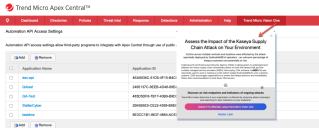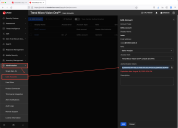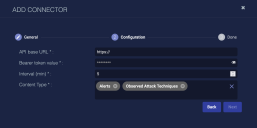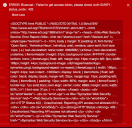Configuring Trend Micro Vision One Connectors
The Trend Micro Vision One connector allows you to collect alert details and observed attack techniques from your Trend Micro deployment, and add that to the Stellar Cyber data lake for analysis and threat hunting.
This topic refers to configuring a Trend Micro Vision One connector. Also see:
Stellar Cyber connectors with the Collect function (collectors) may skip collecting some data when the ingestion volume is large, which potentially can lead to data loss. This can happen when the processing capacity of the collector is exceeded.
Connector Overview: Trend Micro Vision One
Capabilities
-
Collect: Yes
-
Respond: No
-
Native Alerts Mapped: Yes

-
Runs on: DP
-
Interval: Configurable
Collected Data
|
Content Type |
Index |
Locating Records |
|---|---|---|
|
Alerts Observed Attack Techniques |
Syslog |
Domain
|
<API base URL> where <API base URL> is a variable from the configuration of this connector |
Response Actions
N/A
Third Party Native Alert Integration Details
This connector ingests logs from Trend Micro Vision One to get the raw alerts that are stored in the Syslog index.
Stellar Cyber maps Trend Micro Vision One alerts. The alerts are read from the Syslog index, enriched with Stellar Cyber fields, and mapped (with de-duplication) to the Alerts index.
Deduplication is by trendmicro_visionone.workbenchId.
Tactic and Technique are provided by the Trend Micro Vision One raw alerts field trendmicro_visionone.matchedRules.
For details, see Integration of Third Party Native Alerts.
Required Credentials
-
API base URL and Bearer token value
Locating Records
To search the alerts in the Alerts index, use the query: msg_class: trendmicro_visionone_alerts.
To search the Original Records in the Syslog index, use the query: msg_class: trendmicro_visionone_alerts.
Let us know if you find the above overview useful.
Adding a Trend Micro Vision One Connector
To add a Trend Micro Vision One connector:
- Obtain Authentication details for integration
- Add the connector in Stellar Cyber
- Test the connector
- Use the connector
Use our example as a guideline, as you might be using a different software version.
Obtaining Authentication Details for Stellar Cyber Integration
Before you add a Trend Micro Connector, you must obtain information that allows the Stellar Cyber connector to authenticate correctly.
-
Log in to the Trend Micro Apex Central console as the user who will be associated with the Stellar Cyber app (http://manage.trendmicro.com).
-
When the console has loaded, select the menu bar for Vision One. If prompted as below, accept the option to proceed to the next screen.
-
The Vision One Console displays. Navigate to XDR | Managed XDR and ensure it is Enabled.
-
Navigate to Administration tab and access User Accounts.
-
Open the user account that will be associated with your Stellar Cyber connector. Make note of the Authentication token.
-
Click Close.
-
Note the API URL from the location that corresponds to your environment.
Region
FQDN
Australia
api.au.xdr.trendmicro.com
European Union
api.eu.xdr.trendmicro.com
India
api.in.xdr.trendmicro.com
Japan
api.xdr.trendmicro.co.jp
Singapore
api.sg.xdr.trendmicro.com
United States
api.xdr.trendmicro.com
Adding the Connector in Stellar Cyber
After you have noted the authentication information from the Trend Micro app integration, you can add the Trend Micro Vision One connector in Stellar Cyber:
-
Log in to Stellar Cyber.
-
Click System | Integration | Connectors. The Connector Overview appears.
-
Click Create. The General tab of the Add Connector screen appears. The information on this tab cannot be changed after you add the connector.
-
Choose Endpoint Security from the Category drop-down.
-
Choose Trend Micro Vision One from the Type drop-down.
-
For this connector, the supported Function is Respond, which is enabled already.
-
Enter a Name.
This field does not accept multibyte characters.
-
Choose a Tenant Name for the tenants who will have access to this connector.
-
Choose the device on which to run the connector.
-
(Optional) When the Function is Collect, you can create Log Filters. For information, see Managing Log Filters.

-
Click Next. The Configuration tab appears.
The asterisk (*) indicates a required field.
-
Enter the API base URL. Use the table noted in the previous section to add the appropriate URL for your region.
For release versions prior to v4.3.4, ensure the URL does not include a trailing "/" symbol.
-
Enter the Bearer token value. This is the authentication token you copied in the section above.
-
Choose the Interval (min). This is how often the logs are collected.
-
Choose the Content Type you would like to collect. The logs for Alerts and Observed Attack Techniques are supported.
-
Click Next. The final confirmation tab appears.
-
Click Submit.
To pull data, a connector must be added to a Data Analyzer profile if it is running on the Data Processor.
The new connector is immediately active.
Testing the Connector
The Test button for the Trend Micro Vision One connector is unable to distinguish between an expired and a non-expired authentication token. As a result, the test will succeed for expired tokens but the connector will fail.
Note that the test button will correctly fail in other cases, such as incorrectly formatted authentication tokens.
When you add (or edit) a connector, we recommend that you run a test to validate the connectivity parameters you entered. (The test validates only the authentication / connectivity; it does not validate data flow).
For connectors running on a sensor, Stellar Cyber recommends that you allow 30-60 seconds for new or modified configuration details to be propagated to the sensor before performing a test.
-
Click System | Integrations | Connectors. The Connector Overview appears.
-
Locate the connector that you added, or modified, or that you want to test.
-
Click Test at the right side of that row. The test runs immediately.
Note that you may run only one test at a time.
Stellar Cyber conducts a basic connectivity test for the connector and reports a success or failure result. A successful test indicates that you entered all of the connector information correctly.
To aid troubleshooting your connector, the dialog remains open until you explicitly close it by using the X button. If the test fails, you can select the button from the same row to review and correct issues.
The connector status is updated every five (5) minutes. A successful test clears the connector status, but if issues persist, the status reverts to failed after a minute.
Repeat the test as needed.
Using the Connector to Investigate
When an event has occurred on a host known to the Trend Micro connector, you can use this connector to investigate further.
- Click Investigate | Threat Hunting. The Interflow Search tab appears.
- Change the Indices to Syslog. The table immediately updates to show ingested Interflow records.










